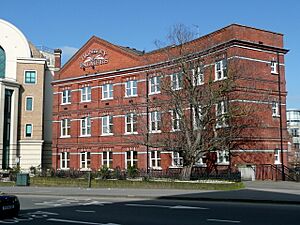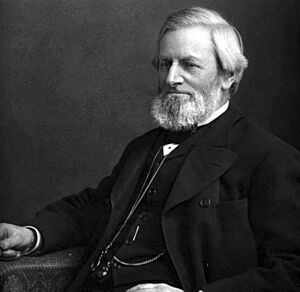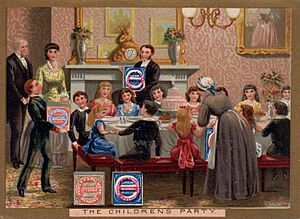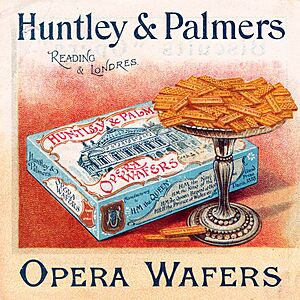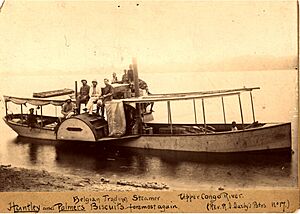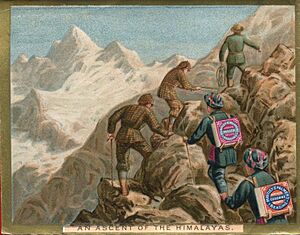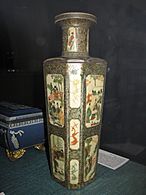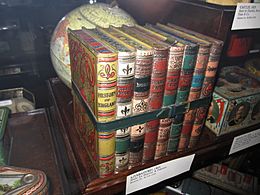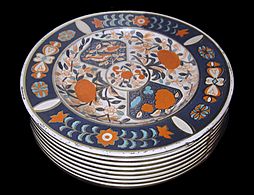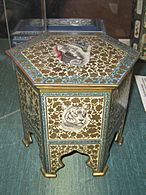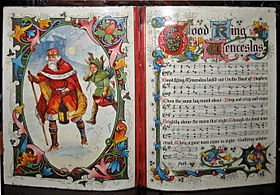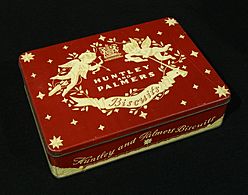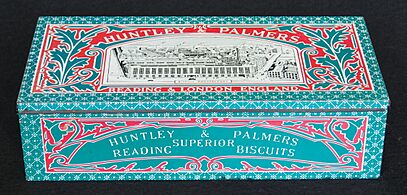- This page was last modified on 17 October 2025, at 10:18. Suggest an edit.
Huntley & Palmers facts for kids
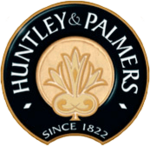 |
|
| Private (1822–1921) | |
| Industry | Food |
| Fate | Merged with Peek Freans to form Associated Biscuits Ltd. in 1921, which was acquired by Nabisco in 1982; Resumed operations in 2006 |
| Founded | 1822 |
| Founder | Joseph Huntley |
| Headquarters |
,
England
|
|
Key people
|
|
| Products | Biscuits |
Huntley & Palmers is a famous British company that makes biscuits. It started in 1822 in Reading, Berkshire, England. The company was founded by Joseph Huntley.
Huntley & Palmers became one of the world's first truly global brands. This means their products were known and sold all over the world! George Palmer joined the company in 1841 and helped it grow a lot. At one point, it had the largest biscuit factory in the world.
Their biscuits were often sold in special, beautifully decorated biscuit tins. By 1900, you could find Huntley & Palmers biscuits in 172 different countries. Their advertisements even showed scenes from all around the globe.
The company was also known by other names over the years, like "J. Huntley & Son" and "Huntley & Palmer." In 2006, the Huntley & Palmers company started making biscuits again in Sudbury, Suffolk. Since 1985, a New Zealand company called Griffin's Foods has also made Huntley & Palmers biscuits under a special agreement.
In 2017, a very old fruitcake from the company was found in Cape Adare. This cake was 106 years old! It was believed to be part of the food supplies for Captain Robert Falcon Scott’s Terra Nova Expedition to the South Pole, which happened between 1910 and 1913.
Contents
The Story of Huntley & Palmers
How It All Started
Huntley & Palmers began in 1822. Joseph Huntley opened a small shop called J. Huntley & Son. It was a bakery that sold biscuits and sweets. The shop was located at 119 London Street in Reading, Berkshire. You can still see a special blue plaque outside the building today.
London Street was a very busy road back then. It was the main route for stage coaches traveling from London to cities like Bristol and Bath. The Crown Inn, a popular stop for stage coaches, was right across from Joseph Huntley's shop.
Joseph started selling his biscuits to the travelers on these coaches. To stop the biscuits from breaking during the bumpy journeys, he began putting them in metal tins. This clever idea led to two successful businesses. One was Joseph's biscuit shop, which grew into Huntley & Palmers. The other was Huntley, Boorne, and Stevens, a company that made biscuit tins. This second company was started by Joseph's younger son, also named Joseph.
George Palmer Joins the Team
In 1838, Joseph Huntley had to retire because he was not well. His older son, Thomas, took over the business. Then, in 1841, Thomas brought in George Palmer as a business partner. George was a distant cousin and a Quaker.
George Palmer quickly became the main reason for the company's huge success. He set up sales agents all over the country. The company soon became too big for its first shop. In 1846, they moved to a large factory on King's Road. This factory was close to the Great Western Railway, which helped them transport their biscuits easily. The factory even had its own internal railway system with steam locomotives! One of these old engines has been saved and can be seen near Bradford.
Thomas Huntley passed away in 1857. But George Palmer continued to lead the company very well. His brothers, William Isaac Palmer and Samuel Palmer, and later his sons, also helped run the business. Huntley & Palmers even became biscuit makers for the British Royal Family.
By 1865, the company started selling its biscuits in Europe. They even received special permissions from leaders like Napoleon III and Leopold II of Belgium. At their busiest, Huntley & Palmers employed over 5,000 people. By 1900, they were the biggest biscuit company in the world!
Their success came from several things. They made many different kinds of popular biscuits, offering 400 varieties by 1903. They also used mass production, which meant they could make lots of biscuits quickly and sell them at good prices. One place they got their flour was Hambleden Mill, located a few miles down the River Thames. Every week, a barge called Maid of the Mill brought flour from the mill to the factory.
The Palmer family was very important in Reading. They gave a lot of money and land to the town, including Palmer Park. Because of the factory, Reading was often called "biscuit town." The local football team, Reading F.C., was even known as the "biscuit men." The company also gave free biscuits to first-class train travelers from Paddington. They encouraged them to look out for the factory when passing through Reading.
Sending Biscuits Around the World
Another big reason for their success was their ability to send biscuits all over the world. The biscuits stayed fresh because they were packed in special, decorated metal biscuit tins. These tins were made locally and became very popular collector's items.
The tins were also a powerful way to advertise. With their easily recognized look, Huntley & Palmers biscuits became a symbol of British trade and influence around the world. Just like Coca-Cola later did for the United States. In 1900, Huntley & Palmers biscuits were sold in 172 countries. Their posters showed pictures of places from all over the globe.
These biscuit tins traveled to far-off places like the heart of Africa and the mountains of Tibet. The company even supplied biscuits to Captain Scott for his 1910 expedition to the South Pole. During the First World War, Huntley & Palmers made biscuits for the soldiers. They also used their tin-making skills to create cases for artillery shells.
In 1921, Huntley & Palmers joined with another biscuit company, Peek Frean from London. They formed a larger company called "Associated Biscuits Manufacturers Ltd." In 1960, W.R. Jacob of Liverpool also joined this group.
Later, in 1969, the three main English biscuit makers – Huntley & Palmers, Peek Frean, and Jacobs – reorganized their production. They became "Associated Biscuits Ltd." This was to compete with other large biscuit companies that had formed.
Biscuit making in Reading stopped in 1976. In 1982, a company called Nabisco bought Associated Biscuits. Production continued at another factory until 1983. After the Peek Frean factory closed in 1989, Nabisco sold the Associated Biscuit brands (Huntley & Palmers, Peek Frean, and Jacobs) to Danone.
Over the years, Huntley & Palmers made more than 400 different kinds of biscuits. They even invented many new types, including the famous Nice biscuit.
Company Records and History
A book about the company's history, called Quaker Enterprise in Biscuits: Huntley & Palmers of Reading, 1822–1972, was published in 1972. This was for the company's 150th anniversary.
Today, the old company records are kept at the Reading Museum. There is a special area in the museum dedicated to Huntley & Palmers. You can even watch old films about the factory there. More company records are stored at the Special Collections of the University of Reading.
A New Beginning
In 2006, Huntley & Palmers started making biscuits again! Their new base is in Sudbury, Suffolk. The team running the company included people who had worked for Jacobs Bakery (which used to own Huntley & Palmers) and experts in packaging design. They decided to focus on making special, high-quality foods.
Since 2008, the Freeman family has owned Huntley & Palmers. This family has been in the biscuit business for three generations! Their goal is to make Huntley & Palmers a well-known name again. They offer different ranges of products for various markets, and yes, they are making those famous biscuit tins once more!
Gallery
See also
- Burton's Foods
- Fox's Biscuits
- Jacob Fruitfield Food Group
- McVitie's
- Tunnock's
- United Biscuits
- Griffin's Foods

